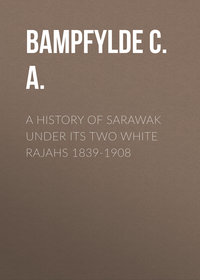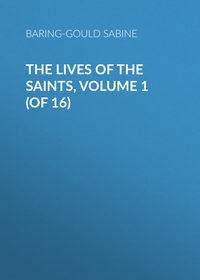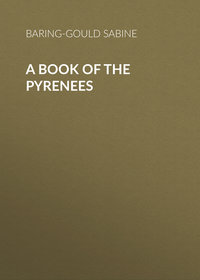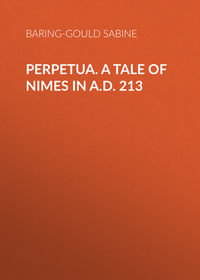 полная версия
полная версияA Book of North Wales
“How can I do that,” said she, “when you are taking possession of the land that belonged to my husband, and should be that of this little one?” Beuno at once stopped the work to inquire into the matter, and found that what the woman had said was true. Then, in great wrath, he ordered his chariot, and drove to the palace of Cadwallon, and asked him how he had dared to give him land which belonged to the widow and orphan.
Cadwallon answered contemptuously that he must take that or none at all. So Beuno would not take it, and swarmed off with his disciples to Clynnog, and settled there on land given him by the king’s cousin, and there ended his days about the year 640. Leland, in his Collectanea (ii. p. 648), relates a curious account given him in 1589 of a custom that prevailed at that period at Clynnog. John Anstiss, Esq., Garter, wrote it.
“Being occasioned the last yere to travaile into mine owne native countrye, in North Wales, and having taryed ther but a while, I have harde by dyvers, of great and abominable Idolatry committed in that countrye, as that the People went on Pylgrymage to offer unto Idoles far and nere, yea, and that they do offer in these daies not only Money (and that liberally) but also Bullockes unto Idoles. And having harde this of sundrye Persons while I was there – upon Whitsondaye last, I went to the Place where it was reported that Bullockes were offered, that I might be an eye witnesse of the same. And upon Mondaye in Whitsonne Week there was a yonge Man that was carried thither the Night before, with whome I had conference concerning the Maner of the Offerings of Bullocks unto Saints, and the yonge man touled me after the same Sort as I had hard of many before; then dyd I aske him whether was ther any to be offered that Daye? He answered that ther was One which he had brought to be offered; I demanded of him where it was? he answered, that it was in a close hard by. And he called his Hoste to goe with him to see the Bullocke, and as they went I followed them into the close, and the yonge Man drove the Bullocke before him (beinge about a yere oulde) and asked his Hoste what it was worth? His Hoste answered that it was worth about a Crowne, the yonge Man said that it was worth more, his Hoste answered and said that upon Sondaye was senight Mr Viccar brought here a Bullocke about the Bigness of your Bullocke for Sixteen Groats. Then the yonge Man said, How shall I do for a Rope against even to tye the Bullocke with? His Hoste answered, We will provide a rope; the yonge Man said againe, Shall I drive him into the Church-yarde? His Hoste answered, You maye; then they drove the Bullocke before them toward the Church-yard; And as the Bullocke dyd enter through a litle Porche into the Church-yarde, the yonge Man spake aloude, ‘The Halfe to God and to Beino.’ Then dyd I aske his Hoste, Why he said the Halfe and not the Whole? His Hoste answered in the yonge man’s hereing, He oweth me th’ other Halfe. This was in the Parishe of Clynnog in the Bishopricke of Bangor, in the yere of our Lord 1589 – Ther be many other things in the Countrye that are verye gross and superstitious; As that the People are of Opinion, that Beyno his Cattell will prosper marvelous well; which maketh the people more desyrous to buye them. Also, it is a common Report amongest them, that ther be some Bullockes which have had Beyno his Marke upon their Eares as soone as they are calved.”
The indignation of the narrator seems to be very unreasonable. One cannot see what difference there is between giving in money and in kind for the keeping up of the church.
But that this was the survival of a sacrifice of a horned animal is possible enough. The custom at Clynnog spoken of fell into disuse only in the nineteenth century; till a little over a hundred years ago it was usual to make offerings of calves and lambs which happened to be born with a slit in the ear, popularly called Nôd Beuno, or Beuno’s mark. They were brought to church on Trinity Sunday, and delivered to the churchwardens, who sold them and put the proceeds into Beuno’s chest. Something of the same sort of thing continues to this day at Carnac, in Brittany, on the feast of S. Cornelius (September 13th). After High Mass horned beasts are blessed at the door of the church. These beasts, donations of the peasants to Cornelly, are then conducted, with a banner borne before them, to the fair, where they are sold for the profit of the church, and are eagerly purchased, for the presence of one in a stable is thought to guarantee the health of the rest for a twelvemonth.
We have recourse to other expedients to raise money for church expenses. I have heard of curates at a bazaar entering into washing competitions, of exhibitions of babies, of beauty competitions as well, of wags grinning through horse-collars, running races carrying eggs in spoons, to raise a few shillings.
A short time ago a bazaar in aid of the funds of a hospital was held in a garrison town in one of the eastern counties. The rector of a certain village not far distant appeared in the costume of an East End costermonger, presided at a stall, and conducted an “auction sale” in the “patter” of the street salesman, to the great disgust of decent-minded people.
At harvest festivals we have donations of fowls, butter, legs of mutton, and hams, to be sold for the good of the church. The donation of bullocks is to be ranked in the same category, and it was a more decent exhibition for a good end than that of curates making tomfools of themselves at bazaars.
CHAPTER VIII
CONWAY
The town of Conway – The castle – Title of Prince of Wales – Archbishop Williams – The church and its screen – Plas Mawr – Caer Seiont – Deganwy – The Yellow Plague – The Sweating Sickness – Llandudno – Overflow of the sea – Gwyddno and Seithenin – Cave with prehistoric relics – The Steward’s Bench – New invasion of North Wales – The tripper – The railway – The Cursing Well – Penmaenmawr – King Helig – The Headland of Wailing – Similar stories – Submarine forests – Chronology of the prehistoric ages – Conovium – Pen-y-Gaer – The purposes of these camps – Underground retreats – Örvar Odd – The salmon-weir of Gwyddno – Elphin – TaliessinCONWAY is an interesting and eminently picturesque town, surrounded, as it still is, by its old walls, and possessing the ruins of the finest castle in Wales – it may perhaps be said in England. This castle occupies one point of the triangle that encloses the town, and has the harbour on one side and the River Gyffin on the other.
The castle was begun in 1283 by Edward I. on the site of a Cistercian monastery, Aber Conwy, and was constructed after the designs of Henry de Elreton, the architect of Carnarvon, and it is said that the workmen employed upon it were brought from Rutlandshire, which produced the best masons in England. It is an extensive structure, and possessed a magnificent dining-hall, built on a curve, the roof formerly sustained by eight stone arches, but of these only two remain. It was lighted by nine Early English windows. At the east end is a chapel, with an apse and a groined roof, lighted by three lancet windows.
The castle was in a decayed condition in the reign of James I. However, it was garrisoned for Charles in the Civil Wars by the warlike Archbishop Williams of York, who, huffed at being superseded by Prince Rupert, went over to the Parliamentary faction and assisted in the attack on the town in 1646. General Mytton took the castle, which was defended by Irish soldiers, and so great was the resentment felt against these auxiliaries, that he had them all tied back to back and flung into the river to drown.
Charles II. granted the castle to the Earl of Conway, who, in 1665, stripped the lead from the roofs and carried off the timbers to convert them to his own use. If it had not been for this, what a residence it would have made for the Princes of Wales, and how pleased the Welsh people would have been to have their Prince living among them!
The Welsh are a loyal people, which the Irish are not, and they are sensitive to consideration. Why should not the Prince of Wales have a stately residence in the Principality? Why should his title be a title only recalling cruel injustice done to this people in the past?
Conway Castle is indisputably finer than any on the Rhine, and its situation and the grouping of the towers are eminently picturesque. The crimson valerian has spread as a gorgeous mantle about the rock on which it is built, and adheres as drops of blood to the crumbling walls.
A short account of Archbishop Williams will not come amiss. John Williams was born at Aberconwy in 1582, and was the second son of William Williams of Cochwillan, in Carnarvonshire. At the age of sixteen he entered S. John’s College, Cambridge. He was a young man of good parts, robust constitution, and with a keen eye for the main chance. It was said of him that he never required more than three hours of sleep out of the twenty-four. He became fellow of his college in 1603. His method in study was this. If he desired to master a subject, he put everything else on one side and concentrated his attention upon it, grappled it to him, and did not let it go till he had thoroughly got to know it in all its aspects.
Having made the acquaintance of Archbishop Bancroft, he obtained access to the King, who took particular notice of him, and when he entered Holy Orders he obtained one preferment after another. In 1617 he was made a prebendary of Lincoln, Peterborough, Hereford, and S. David’s, in addition to a rectory in Northamptonshire and a sinecure in North Wales. He was also chaplain to the King, and had to receive and entertain that eccentric man Marco Antonio de Dominis, Archbishop of Spalato, who had quarrelled with the Pope and came to England. In 1619, not satisfied with all his preferments, he obtained the deanery of Salisbury, and the year following, that of Westminster. In 1621 he was made Lord Keeper of the Great Seal of England, and was raised to the bishopric of Lincoln, which he held along with the deanery of Winchester and his Northamptonshire rectory.
On the death of James I., whom he attended at the last, he fell out with the Duke of Buckingham, and Charles I. took the Great Seal from him in 1626. Afterwards, on some charges brought against him in the Star Chamber, he was fined ten thousand pounds, suspended from all his functions, dignities, and emoluments, and sent to prison in the Tower for three years and a half. The King was, however, soon reconciled to him, cancelled all orders that had been made against him, and in 1641 he was advanced to the archbishopric of York.
When war broke out between the King and the Parliament, he took the side of the former, and had to fly from York, as the younger Hotham was marching on York, and had sworn to capture and kill him for having commented strongly on the manner in which Sir John Hotham had seized on the King’s magazine of arms at Hull.
Archbishop Williams hasted to Conway and fortified the castle for the King, and Charles, by letter from Oxford, “heartily desired him to go on with the work, assuring him that whatever moneys he should lay out upon the fortification of the said castle should be repaid him before the custody thereof should be put into any other hand than his own.”
The good people of Conway town placed all their valuables in the castle for security.
In 1645 Sir John Owen, a colonel in the King’s army, obtained from Prince Rupert the appointment to the command of the castle. This the archbishop angrily resented, as the King had assured the governorship to him till the money he had dispensed should be repaid. Charles could not raise the requisite sum, and the castle was too important not to be placed under a soldier instead of a churchman. He accordingly went over to the side of the Parliament, and with the assistance of Colonel Mytton, the Parliamentarian officer, forced the gates and secured that stronghold for the faction against which he had hitherto contended.
Williams, in fact, had been keen-sighted enough to see that the King’s affairs were falling into ruin in all quarters, and he characteristically joined the winning side.
But if Williams had reckoned on retaining his archbishopric and other emoluments as the price of his treachery, he was mistaken. The rest of his life was spent in seclusion, in vain regrets, and it is said in sincere repentance, rising from his bed at midnight and praying on his bare knees, with nothing on but his shirt and waistcoat. He died at Gloddaith, near Conway, in 1650, and was buried in Llandegai Church, where a monument was erected to him by his nephew, Sir Griffith Williams.
Conway Church is good, with a fine tower and an Early Decorated chancel that has a Perpendicular east window inserted. But the greatest treasure of the church is its magnificent rood-screen; and there are good stalls in the choir.
Plas Mawr is a specimen of a Welsh gentleman’s house of the sixteenth century, with panelled rooms and quaint plaster ceilings. The house has fifty-two doors, as many steps up the tower, and 365 windows.
Rising above Conway is Caer Seiont, where are circles of stones and embankments, the remains of a camp probably dating from the Irish possession of Gwynedd. The railway is carried through a tunnel in a spur of the hill. A glorious view is obtained from the summit, of the sea, the Great Orme’s Head, and the valley of the Conway dotted with houses. Near the mouth of the river on the further bank is Deganwy, once the royal residence of Maelgwn, king of Gwynedd, a bold warrior, but terribly nervous about his health, apparently, for when the Yellow Plague, in 547, broke out he took to his heels. However, the plague went after him, and he died of it.
But Maelgwn was not the only one to run away. Teilo, Bishop of Llandaff, fled, taking with him his clergy, and sheltered in Brittany till the disorder had passed. The Yellow Plague would seem to have been a very infectious sickness attacking the bilious glands and producing jaundice. It spread to Ireland and committed frightful ravages both there and in Britain. As neither Bede nor the Anglo-Saxon Chronicle makes any allusion to it, the plague cannot have touched the English, but was confined to the Celtic lands. It, however, broke out again in 664.
The plague of 547-50 created the liveliest panic. In Ireland it was thought that the only escape from it was to put “seven waves” between the soil of Erin and a place of refuge, and monks and princes fled to the islands. Maelgwn, in a panic, assumed the habit of a monk, and escaped to the church of Llanrhos, intending to go further, but died there. It is curious that twice again a plague was thought to have originated in Wales. The next was the Sweating Sickness, the germs of which were carried to Bosworth by the army of Richmond, and which after the victory there spread in a few weeks from Bosworth and the Welsh mountains to London. Those afflicted with it had their powers prostrated as by a blow; they suffered intense internal heat, yet every refrigerant was certain death. Not one in a hundred who was attacked escaped at first. The physicians were bewildered; they turned over the pages of Galen and found that the disease was not described there, nor were any remedies prescribed for any malady that at all resembled it. Death came quickly; a day and a night after a man was attacked he was a corpse. The battle of Bosworth was fought on August 22nd, 1485, and Henry entered London on the 28th. Immediately the Sweating Sickness began its ravages. The Lord Mayor and six aldermen died within a week. The sickness struck at the most vigorous and robust men, and from London it spread like wild-fire throughout the kingdom. The coronation of the King had to be postponed, and did not take place till October 30th.
As the physicians were quite at a loss how to deal with the malady, the people looked to common sense, and found that the best of doctors. Directly a man felt the fire in him, and the sweat began to stream from every pore, he took to his bed, not even staying to take off his clothes, and was given only liquids, and these hot.
The plague broke out again in 1551, not exactly in Wales, but at Shrewsbury. All the spring clammy fogs had hung over the Severn valley, and suddenly, on April 15th, the Sweating Sickness again appeared. The visitation was so general at Shrewsbury and in the basin of the Severn that everyone believed that the air was poisoned. The disease came unexpectedly and without warning – at table, during sleep, on journeys, in the midst of amusement, and at all times of the day. Some died within an hour of the attack; none who had it mortally survived four-and-twenty hours.
Crowds of fugitives escaped to Ireland and Scotland, some embarked for France or the Netherlands, but it was remarked that the Sweating Sickness struck down only the English, not foreigners in England, nor did it spread from the refugees abroad. Within a few days nine hundred and sixty of the inhabitants of Shrewsbury died.
Thence it rapidly spread throughout England. The banks of the Severn were, however, the focus of the malady, and a fetid mist was thought to hang over the river, “which mist,” says a writer of the time, “in the countrie wher it began, was sene flie from towne to towne, with such a stincke in morninges and evenings, that men could scarcely abide it.” It lasted from 15th April to 30th September.
To return to Deganwy, from which we have wandered. It was struck by lightning in 812, but was speedily restored. Hugh the Fat, Earl of Chester, made it his stronghold, but it was taken and demolished by Llewelyn ab Gruffydd in 1260.
Llandudno, on the neck of land connecting the Great Orme’s Head, or Pen y Gogarth, with the mainland, has grown into a fashionable watering-place. The Head rises to the height of nearly 680 feet above the sea; on the Conway side was an ancient monastic settlement at Gogarth. In the first half of the sixth century a low-lying tract of land, now overflowed by the sea, formed a hundred called Cantref y Gwaelod, in Cardigan Bay. It was probably a portion of land that had been reclaimed by the Romans from the waves by strong sea walls. This district was ruled by two chiefs, Gwyddno and Seithenin. The story goes that owing to the neglect of Seithenin, who was a drunkard, and whose duty it was to see to the repairs of the walls, one stormy night the rollers coming in with an unusually high tide and wind, the dykes were overleaped, and the whole cantref was covered with sea.
With difficulty did the sons of Gwyddno escape with their lives, and as they had lost their lands and tribal rights, nothing was open to them save to enter religion and found ecclesiastical tribes. Among the sons of the tipsy Seithenin was Tudno, who settled on the Orme’s Head. But here also was a great inundation, as we shall see presently. The church, which is of the twelfth century with a fifteenth-century chancel, was for some time left in ruins, but it has been restored, and service is now held in it in summer. In the interior is an early circular font.
In 1881 a cave in the limestone was discovered behind Mostyn Street in Llandudno, which had been inhabited in prehistoric times, for beside the bones of cave bears, were found skeletons of men, and a necklace of pierced teeth of beasts. These were the relics of that primeval race which began to settle in the land as the Ice Age came to an end and the glaciers disappeared.
There are many caves in the limestone rock of the Head, one fitted up as a summer-house, by some of the Mostyn family, with stone seats and tables. A small cromlech and some rude stone remains on the headland may be seen, but the relics are sadly mutilated.
Pen y Ddinas overhangs the town, and on it is a logan rock, the Maen Sigl, which is also called S. Tudno’s cradle.
A stony ledge runs out to sea, and is covered at high tide with about two feet of water, and is named the Steward’s Bench. Here, according to tradition, a steward of the Mostyn family, who had been convicted of peculation, was compelled to sit naked during the flow and reflow of two tides.
The entire north coast of Wales, after having been invaded by the Gwyddyl, and then by the Britons from Strathclyde, and next by the Normans, has been invaded by a horde of trippers. It has been taken possession of by them for the summer months. The horde derives from Manchester, Liverpool, and Birmingham; and every vantage place is laid out with piers, promenades, pavilions; and for the delectation of the holiday-makers there are Ethiopian serenaders, dancing-dogs, cheap-jacks, organ-grinders, and monkeys.
The intelligent tourist, knowing that the chief study of mankind is man, will find endless amusement in observing his fellow-Englishmen and women when out on a spree. The bow must at times be relaxed, but when it is, it does not invariably take a graceful form.
How the North Welsh coast has changed within a century in its aspect may be gathered from a letter of Mr. Gladstone, which describes it some eighty years ago.
“I remember,” he says, “paying my first visit to North Wales, travelling along the North Wales coast as far as Bangor and Carnarvon, when there was no such thing as a watering-place, no such thing as a house to be hired for the purpose of those visits that are now paid by thousands of people to such multitudes of points all along the coast. It was supposed that if any body of gentlemen could be found sufficiently energetic to make a railway to Holyhead, that railway could not possibly pierce the country, and must be made along the coast, and if carried along the coast, could not possibly be made to pay. So firm was the conviction that – I very well recollect the day – a large and important deputation of railway leaders went to London and waited on Sir Robert Peel, who was then Prime Minister, in order to demonstrate to him that it was totally impossible for them to construct a paying line, and therefore to impress upon his mind the necessity of his agreeing to give them a considerable grant out of the consolidated fund. Sir Robert Peel was a very circumspect statesman, and not least so in those matters in which the public purse was concerned. He encouraged them to take a more sanguine view. Whether he persuaded them into a more sanguine tone of mind I do not know. This I know, the railway was made, and we now understand that this humble railway, this impossible railway, as it was then conceived, is at the present moment the most productive and remunerative part of the whole vast system of the North-Western Company.”
Prestatyn, Rhyl, Abergele, Colwyn, Llandudno, Penmaenmawr, Aber – what a string it forms of bathing-places, ever extending and threatening in time to run a continuous line of lodging-houses and hotels along the entire coast!
S. Elian’s Well is a little beyond Colwyn. It is now filled up, and the structure over it has been destroyed, for the place was in bad repute, and was resorted to for no good purpose. The spring was a Cursing Well, and here from time immemorial a guardian ministered to the resentments of the ill-disposed. Anyone who bore a grudge against another, and believed himself to have been wronged, would resort to this well to “throw in” his adversary. A writer of the beginning of last century says: —
“The well of S. Elian lies in a dingle near the high road leading from Llanelian to Groes yn Eirias. It was surrounded by a wall of 6 feet high, and embosomed in a grove; but the trees have fallen and the wall is thrown down. It was resorted to by the Welsh to call imprecations and the vengeance of the saint on any who had done them an injury. Mr. Pennant says that he was threatened by a person he had offended with a journey to the well to curse him with effect. The ceremony was performed by an old woman, who presided at the font, in the following manner. After having received a fee, the name of the offender was marked on a piece of lead; this she dropped into the water, and mumbled imprecations, whilst taking from and returning into the water a certain portion of it. It frequently happened that the offending party who had been the subject of her imprecations sought through the medium of a double fee to have the curse removed; and seldom was this second offer refused by her. On this occasion she took water from the well three times with the new moon, select verses of the psalms were read on three successive Fridays, and a glass of the well water drunk whilst reading them.”
The well became such an occasion for ill-feeling that a former incumbent of the parish had it destroyed.









